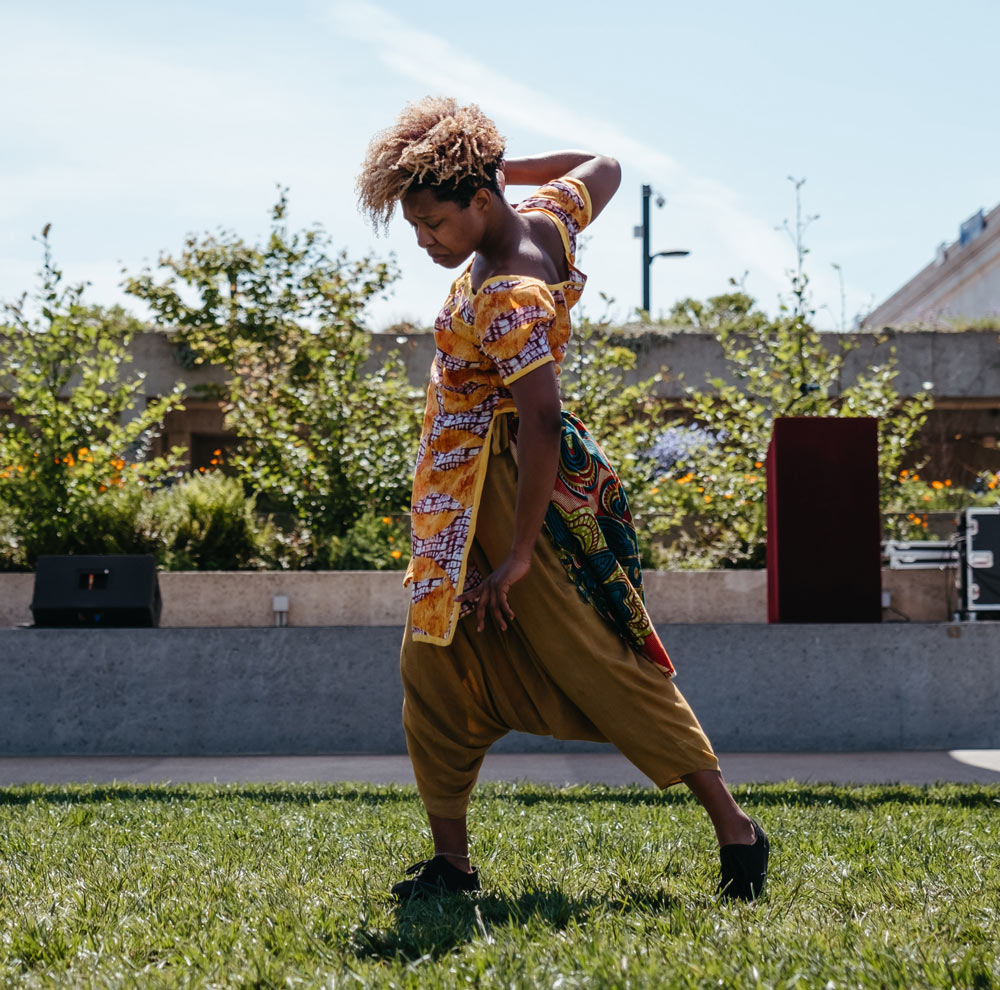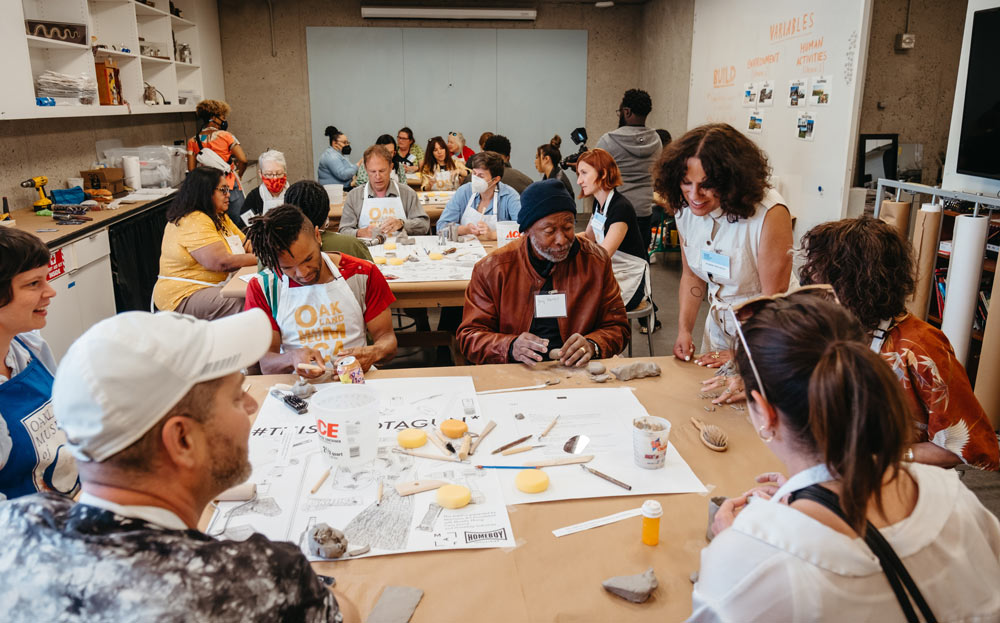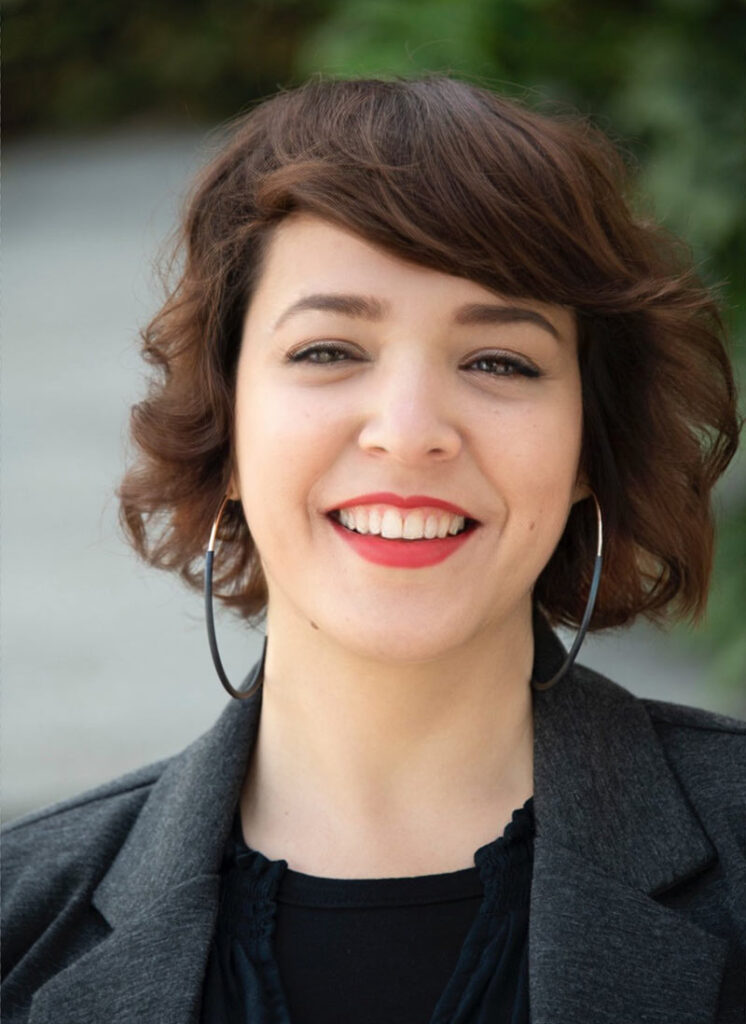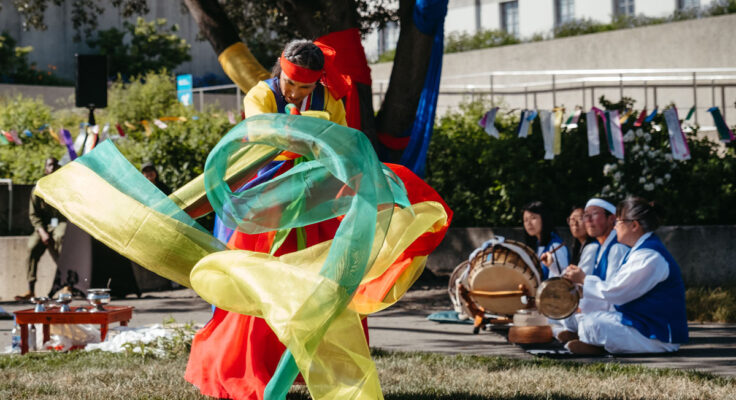In April, we gathered for the fourth Exploring Public Art Practices Symposium, a partnership between the Kenneth Rainin Foundation and Oakland Museum of California (OMCA). The day-long event, captured in the video below, featured inspirational conversations, workshops and performances that reinforced our belief in the power of public art to interrogate systems of oppression, reimagine new ways of being in the world and help us heal.
We invited OMCA’s Rhonda Pagnozzi, who programmed the Symposium, to share her thoughts and reflections.
Guest Blog By Rhonda Pagnozzi, Oakland Museum Of California
On April 29, 2023, OMCA hosted the Rainin Foundation’s Exploring Public Art Practices Symposium, which brought together artists and cultural producers to investigate the power of art in the public realm. This year’s theme, Healing Justice, offered a poignant and timely topic to the Symposium. After three years of a global pandemic, ongoing racial unrest, climate disasters and a divisive political landscape, public artists are turning to practices that offer opportunities to engage in communal healing.
The day-long event featured performances, presentations and conversations that explored practices that are pushing the boundaries of what it means to heal in the midst of challenging times.
The Theme Healing Justice
When we began curation of this year’s Symposium we asked ourselves, “What does the public need in this moment?” As we reflected on this question the broader context of the so-called post-pandemic world pressed on. What surfaced was the need to heal from the systems that are harming us; man-made systems that produce health, climate and economic crises.
During this period of reflection, I was reminded of a poem by healer and activist Cara Page titled Are We Ready to be Well? Page writes, “We cannot be well until…we pour libations for the ancestors so that they may rest.” We cannot heal without naming the loss of connection and dignity through severed cultural memory, traditions, land and resources.
Artists and cultural producers have long known what a growing body of evidence is beginning to show, that art moves us toward healing justice. Art gives voice to global suffering and provides us with a portal into new ways of being in the world, helping us to imagine a reality that dismantles systems of oppression.
Supporting Wellness
One of the Symposium’s goals was to expand the capacity to measure how OMCA’s programs can help support wellness. To that end, participants were prompted to provide real-time feedback and to complete a post-event survey. They also had the option of participating in a phone interview with OMCA’s Evaluation Team. Overall responses were positive and many concluded that the Symposium modeled how public art can support healing, wellness and self-care. Explore the results of OMCA’s surveys.
Returning To The Garden

To highlight the spirit of healing justice, we centered the Symposium in the natural beauty of OMCA’s newly renovated public Garden. This open, free-flowing shared public space offered visitors a standing invitation to return to The Great Lawn throughout the day.
As guests trickled into the sunlit Garden, performer Keisha Turner began her movement-based exploration titled Maroon is My Favorite Color (excerpt). This piece was an invitation to consider how Diasporic Africans might “maroon,” that is, self-emancipate and collectively recover from oppressive systems in a contemporary setting. As she stretched, contorted and served fruit to onlookers, her offering of Black liberation set our intentions for the day. The emcee, multimedia artist Alex Bledsoe, followed with her spoken word piece “...What’s to become of the child of empire and revolution? When being alive in public is a crime. Meet me by the trees…” She then wove us through the day with gentle reflections and peppered in conversation prompts.

Inspired by the morning offerings, guests dispersed into the first round of breakout sessions. Artistic Collaboration in Grassroots Performance was a workshop conducted in Spanish in which Andreína Maldonado led the group in somatic methodologies for collaboration as they relate to storytelling, wellness and returning to our bodies. The This is Not a Gun workshop, led by Angela Hennessy and developed with Cara Levine, challenged guests to recreate objects in clay that police have mistaken for guns, increasing awareness of racial profiling while creating a space for healing our hearts. With News as Justice (a two-part workshop), The Oakland Lowdown asked how might we reframe local news as a force for liberation to elevate narratives of wholeness and build power in our communities.
With our minds, bodies and spirits engaged we gathered back in the Garden for a community meal curated by La Cocina and Wahpepah’s Kitchen. Crystal Wahpepah, of Wahpepah’s Kitchen, framed the experience from the Garden stage. She spoke about being a member of the Kickapoo nation and being raised on Ohlone land, surrounded by a multi-tribal urban Native community. She explained how her experience was a portal into food sovereignty and a reclamation of ancestral knowledge, claiming ground for sustainable ways to nourish ourselves and the planet.
The second round of breakout sessions featured the Future IDs Art & Justice Leadership Cohort forum, which centered a discussion about system-impacted and allied changemaker justice reform. Creando Espacio/Making Space with Hector Dionicio Mendoza highlighted his installations that uplift ritual and the healing traditions of curanderismo (shamanism) that draw from memories of his childhood in Mexico with his grandfather, a fifth-generation curandero. Artist Damien McDuffie created a digital interactive to activate OMCA’s exhibition Angela Davis: Seize the Time. Using McDuffie’s Black Terminus app, our phones became a living canvas with footage from the life of justice seeker, Angela Davis.
Throughout the day guests were invited to write “what their ancestors, families and communities need for healing” on strips of paper and hang their responses on Dohee Lee’s colorful ribbon installation under the Garden oak tree. We settled on The Great Lawn for the day’s final offering. Dohee Lee and seven MU ritual drummers electrified us with their transformative Ritual for Sickness: 칠성 새남굿- Chilseong SaenamGut (Duringut). They purged monstrous forces and invited in vital spirits. Then in joyous laughter, Lee invited us all to dance. It was a magical ending.
Still vibrating from Lee’s invocation, I thought of a quote by Alex Bledsoe: “may we have the courage to be creative, may creativity bring us closer together, and may that closeness bring us healing.”

About The Author
Rhonda Pagnozzi is the Manager of Learning, Experience and Programming at OMCA. She curates and writes about experiences that illuminate the people and ideas that drive and shape California and beyond.
Pagnozzi’s most recent projects include Assistant Curator for “Queer California: Untold Stories;” Lead Curator for “Mothership: Voyage Into Afrofuturism;” and Program Lead for “Abolition: A Multigenerational Perspective” featuring Angela Y. Davis.

